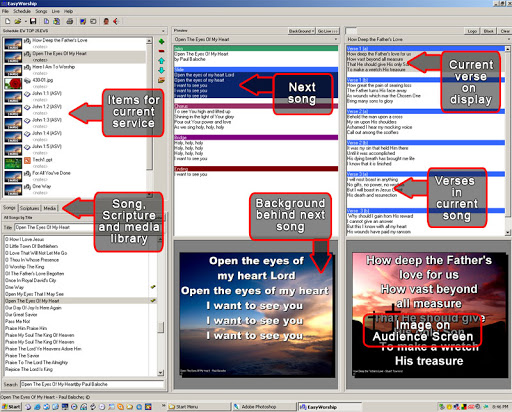
- #EASYWORSHIP 7 WINDOWS 10 NOT BRIGHT ENOUGH FULL#
- #EASYWORSHIP 7 WINDOWS 10 NOT BRIGHT ENOUGH CODE#
- #EASYWORSHIP 7 WINDOWS 10 NOT BRIGHT ENOUGH WINDOWS 8#
- #EASYWORSHIP 7 WINDOWS 10 NOT BRIGHT ENOUGH DOWNLOAD#
- #EASYWORSHIP 7 WINDOWS 10 NOT BRIGHT ENOUGH WINDOWS#
Set objshell = CreateObject(“wscript.shell”)
#EASYWORSHIP 7 WINDOWS 10 NOT BRIGHT ENOUGH WINDOWS#
If vbYes = MsgBox(ProductData & vblf & vblf & “Save to a file?”, vbYesNo + vbQuestion, “BackUp Windows Key Information”) then ProductKey = “Installed Key: ” & ConvertToKey(DigitalID) ProductID = “Product ID: ” & objshell.RegRead(Path & “ProductID”) ProductName = “Product Name: ” & objshell.RegRead(Path & “ProductName”)

Path = “HKLM\SOFTWARE\Microsoft\Windows NT\CurrentVersion\”ĭigitalID = objshell.RegRead(Path & “DigitalProductId”) Set objshell = CreateObject(“WScript.Shell”) It can also be made to work with Windows XP by modifying the script a bit…. Private Sub Button1_Click(ByVal sender As System.Object, ByVal e As System.EventArgs) Handles Button1.Click & “!\\” & strComputer & “\root\cimv2”)ĭim colBIOS As Object = objWMIService.ExecQuery _ Private Sub Button2_Click(ByVal sender As System.Object, ByVal e As System.EventArgs) Handles Button2.Clickĭim objWMIService As Object = GetObject(“winmgmts:” _ If (TextBox1.Text) = “” Then Button2_Click(sender, New System.EventArgs) TextBox1.Text = ConvertToKey(“HKEY_LOCAL_MACHINE\Software\Microsoft\Windows NT\CurrentVersion”, “DigitalProductID”) TextBox1.Text = ShowMyKey(“HKEY_LOCAL_MACHINE\Software\Microsoft\Windows NT\CurrentVersion”, “DigitalProductID”) If Strings.Left((TextBox2.Text), 11) = “Windows 8.1” Then GoTo Volg1 If Strings.Left((TextBox2.Text), 9) = “Windows 8” Then GoTo Volg1 If Strings.Left((TextBox2.Text), 10) = “Windows 10” Then GoTo Volg1 Private Sub Form1_Load(ByVal sender As System.Object, ByVal e As System.EventArgs) Handles MyBase.Load K = My.(“HKEY_LOCAL_MACHINE\Software\Microsoft\Windows NT\CurrentVersion”, “ProductName”, Nothing)įunction ConvertToKey(ByVal Path As String, ByVal Name As String) As StringĪ(66) = (A(66) And &HF7) Or ((isWin8 And 2) * 4) Public Function ShowMyKey(ByVal Path As String, ByVal Name As String) As Stringĭim A As Object = My.(Path, Name, 0)įor i As Integer = LBound(A) To UBound(A)
#EASYWORSHIP 7 WINDOWS 10 NOT BRIGHT ENOUGH CODE#
#Region ” Windows Form Designer generated code ” It’s written in Visual Basic 2008, but you maybe can transform it in later versions.Ĭreate a form with 2 textboxes called Textbox1 & Textbox2
#EASYWORSHIP 7 WINDOWS 10 NOT BRIGHT ENOUGH FULL#
Here I have the full code to view any windows key also the ones they put in the bios. It works flawlessly in all mentioned operating systems.
#EASYWORSHIP 7 WINDOWS 10 NOT BRIGHT ENOUGH WINDOWS 8#
I tested this trick on Windows 7, Windows 8 and Windows 10.
#EASYWORSHIP 7 WINDOWS 10 NOT BRIGHT ENOUGH DOWNLOAD#

Now open your BackupWindowsKey.vbs file.Save the text above to a file with the ".vbs" extension on the Desktop.īonus tip: To make sure that you saving the file correctly with the ".vbs" extension, you can type its name enclosed in double quotes, for example, "BackupWindowsKey.vbs".Set fso = CreateObject("Scripting.FileSystemObject") UserName = objshell.ExpandEnvironmentStrings("%UserName%")įName = "C:\Users\" & UserName & "\Desktop\WindowsKeyInfo.txt" Set objshell = CreateObject("wscript.shell") If Last = 0 Then KeyOutput = insert & KeyOutputĬonvertToKey = Mid(KeyOutput, 1, 5) & "-" & Mid(KeyOutput, 6, 5) & "-" & Mid(KeyOutput, 11, 5) & "-" & Mid(KeyOutput, 16, 5) & "-" & Mid(KeyOutput, 21, 5) KeyOutput = Replace(KeyOutput, keypart1, keypart1 & insert, 2, 1, 0) KeyOutput = Mid(Maps,Current+ 1, 1) & KeyOutput If vbYes = MsgBox(ProductData & vblf & vblf & "Save to a file?", vbYesNo + vbQuestion, "BackUp Windows Key Information") thenĭim isWin8, Maps, i, j, Current, KeyOutput, Last, keypart1, insert ProductData = ProductName & vbNewLine & ProductID & vbNewLine & ProductKey ProductKey = "Installed Key: " & ConvertToKey(DigitalID) ProductID = "Product ID: " & objshell.RegRead(Path & "ProductID") ProductName = "Product Name: " & objshell.RegRead(Path & "ProductName") Path = "HKLM\SOFTWARE\Microsoft\Windows NT\CurrentVersion\"ĭigitalID = objshell.RegRead(Path & "DigitalProductId")ĭim ProductName,ProductID,ProductKey,ProductData Set objshell = CreateObject("WScript.Shell") Copy and paste the following text into the Notepad window Option Explicit.

All you need to do is to just click the file. PowerShell might require additional user skills and extra tweaks to run unsigned cmdlets.Ĭompared to PowerShell, this VBScript solution is almost perfect. but many users complained that it fails for them. Actually, earlier I posted a similar solution which used PowerShell.


 0 kommentar(er)
0 kommentar(er)
